Is SEO Part of the Web Design Process?
“When you’re designing a website, you need to consider the audience, the device, the browser, the aesthetics and the search engines.”
We all know that web designers can create beautiful, eye-catching, clever websites but what good is all that creativity if no one ever visits the site?
As SEO specialists we need to help the design community understand that SEO is part of the web design and development process and not something that’s fixed after the website is complete.
The truth about SEO and design
As a web designer, you’re probably focusing on User Experience, aesthetics, browser size and device restrictions – well now it’s time to add SEO to that list. Why? Well given that 80% of website traffic comes from search engines, if you don’t design for them, your client’s website is going to get little or no traffic.
The hard truth is that:
- Many award-winning websites (featured on sites like Awwwards and theFwa) don’t rank on search engines. Don’t believe us? Read this;
- Often SEO consultants have to redesign a large portion of the website to ensure it meets search engine requirements;
- There won’t be any “user experience” if the website doesn’t get traffic;
- Most searches online are for unbranded keywords.
Designer’s Listen Up, You Can’t Ignore SEO is available in several languages on Kate Toon’s Website
Your client and SEO
It’s important to understand that most clients will assume their website will rank for their chosen keywords. They want SEO even though they don’t really know what it is. They probably won’t realize it’s an additional service. So, it’s up to YOU to explain the ins and outs of Search Engine Optimization and how it will affect their design.
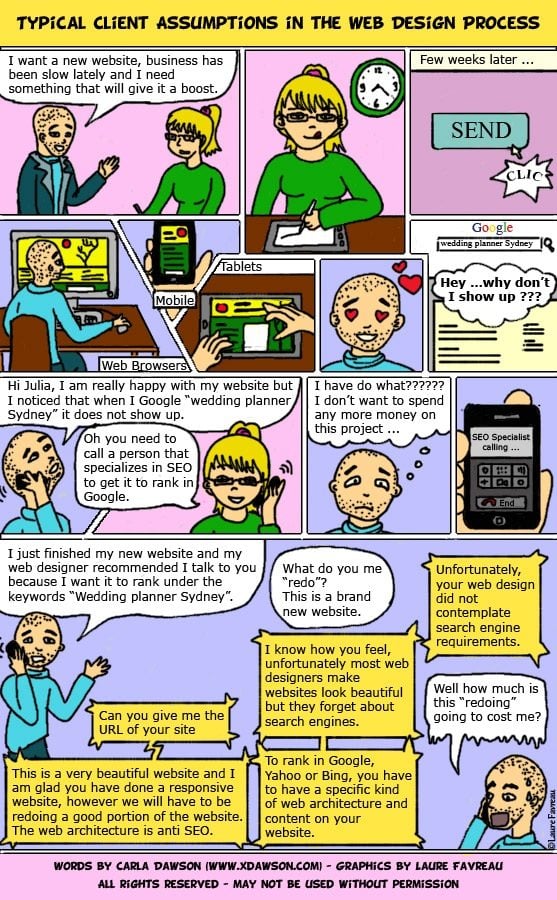
The client may say this:
“Business has been slow lately and I need to give it a boost – so I want a new website.”
But what they mean is this:
“I want more leads.”
So, if you go ahead and create a website with no regard for SEO: it won’t rank and there won’t be any leads – no matter how gorgeous it looks.
At the end of the day, websites are marketing tools that are used to create a business.
So, create a site that doesn’t generate leads and you’ve failed as a web designer.
Don’t panic!
Designing a great looking website that meets SEO requirements isn’t more expensive or difficult. It’s just about understanding the basic rules and acknowledging that the Search Engines are how customers find the website.
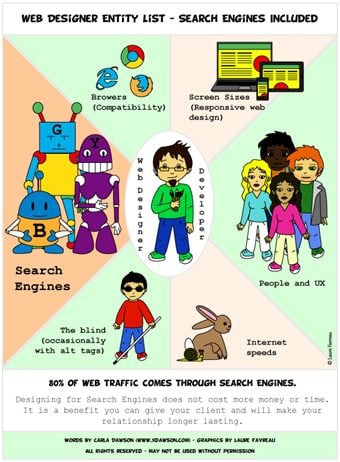
Basic SEO guidelines for web designers
These days, Search Engine Optimization falls into two main areas:
- On-page SEO (30%) –web architecture, semantics, content and the way the site is coded;
- Off-page SEO (70%)–sometimes known as link building or content marketing.
As a web designer, your focus should beOnpage SEO. Here are three great articles to get you started:
- Site Architecture for SEO. Yes, I know this article is old but it is 100% true today
- The Web Developers SEO Cheat Sheet 2013 Edition
- Really advanced and awesome SEO stuff here: Visual Guide To Keyword Targeting Onpage Optimization
Know your client
Essentially there are three main client types, and how you design and build your site will depend on determining which category your client falls into.
1. I used to advertise on Yellow Pages, but now I want my website to show up in Google, Yahoo, and Bing for non-branded keywords.
(For example: Wedding planners, Locksmiths, Plumbers, Real estate agents, companies offering niche products or services, companies with generic brand names.)
Recommendation: Partner with an SEO agency or expert so they can focus on the site architecture and content and you can focus on the aesthetics. If your client really wants SEO, you need to work with the experts.
2. I want a creative site and I want to rank for my brand term.
(For example: brands that have a strong brand position already through other media: Nike, Adidas, McDonald's, Coca-Cola, etc.)
Recommendation: Although these kinds of clients may not want to rank under non-branded traffic, we still recommend asking them if they are interested. If they are interested you’ll have to design with some SEO requirements in mind.
3. Most of my business comes from referral and offline marketing
(For example: Well known lawyers or doctors and established local businesses that have already accomplished “branding” the traditional way.)
Recommendation: Although these kinds of clients seem to have solid marketing channels, they still might be interested in ranking under non-branded traffic. Our recommendation is to ask them questions like, “Are you interested in getting clients through Google or other search engines?” You might be surprised by their answers. If they do want to rank, SEO requirements will have to be incorporated in your design.
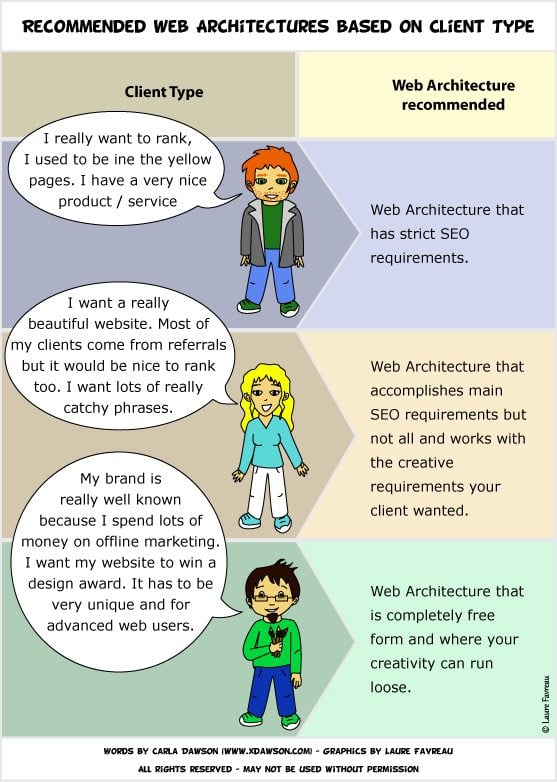
Client type 1: SEO and Design combined
SEO Gadget
The SEO Gadget looks great but includes the following SEO friendly elements:
- Unique Title Tags and Meta Descriptions for each page with considered keyword targeting;
- A keyword oriented architecture that helps the website rank under several different phrases;
- A quick loading time;
- A consistent address in the footer;
- Fresh content on the homepage;
- A content-rich blog.
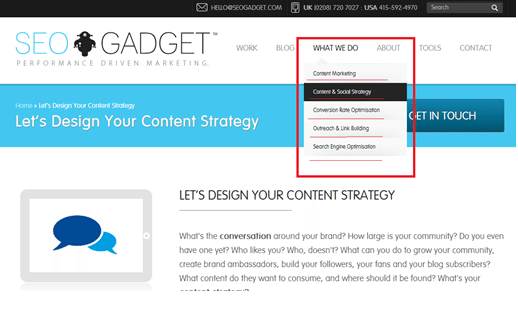
Client type 2: Some SEO considered
These sites are often the hardest to produce. They target keywords and have an SEO friendly architecture, but also take account of aesthetics.
Softacade.com is a great example where there is a relatively good architecture but also amazing graphics.
Client type 3: None SEO constrained design
On the Mercedes Benz site, a one-page parallax scrolling design has been used that is less SEO friendly.
This is the kind of website that usually wins awards but won’t to rank for generic keywords, but since the brand is so well known, SEO is not really an issue.
SEO is part of the design process
So, next time you’re designing a site, consider SEO as part of the process, not an annoying afterthought. A website with a strong SEO foundation will prove a successful business tool for your client – and happy clients equal happy designers.
If you want to learn more about SEO for the web design process, check out these great resources:
- Site Architecture for SEO;
- The Web Developers SEO Cheat Sheet 2013 Edition;
- Visual Guide To Keyword Targeting Onpage Optimization.
This article was co-authored by Kate Toon and illustrations were done by Laure Favreau. Kate Toon is an award-winning SEO copywriter and SEO consultant with over 18 years’ experience. Laure Favreau is a Junior Web and Graphic Designer. She loves to learn new techniques about the design process.
SEO audit by TemplateMonster Service Center
Do you need your website be visible to your target audience in search engines and you don't know where to start? SEO audit is the first step to creating an online marketing strategy that really works. You will get the analysis and guidelines on how to implement the given recommendations within your website.
Get more to your email
Subscribe to our newsletter and access exclusive content and offers available only to MonsterPost subscribers.


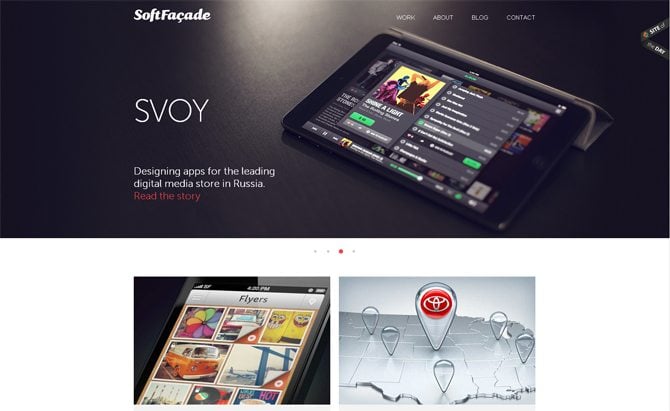

Leave a Reply
You must be logged in to post a comment.